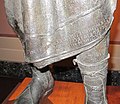User:H.cathcart/sandbox
 | This is a user sandbox of H.cathcart. You can use it for testing or practicing edits. This is not the sandbox where you should draft your assigned article for a dashboard.wikiedu.org course. To find the right sandbox for your assignment, visit your Dashboard course page and follow the Sandbox Draft link for your assigned article in the My Articles section. |
| Aule Metele (The Orator) | |
|---|---|
 | |
| Year | 110-90 BCE |
| Medium | bronze sculpture |
| Dimensions | 179 cm (70 in) |
| Location | National Archaeological Museum, Florence |
The statue called The Orator (English) is also known as L' Arringatore (Italian), or Aulus Metellus (Latin). The sculpture was made out of bronze during the late second or the early first century BCE and is a Etruscan work of art.[1] Aulus Metellus was an Etruscan senator in the Roman republic.[2] The Aulus Metellus sculpture was found in 1566 with the exact location being up for debate, but all sources agree the sculpture was found either in or around Lake Trasimeno in the Perugia provence of Italy,[2][3] 177 kilometers (110 miles) from Rome.
Description
[edit]The statue of Aulus Metellus is 179 cm in height[1] ( or 5'8" in empirical measurements). The statue wears a toga exigua, consisting of a short sleeved tunic underneath a close fitting toga, slung over the left arm and shoulder while leaving the right arm free for movement. The hem starts over the left ankle and heads diagonally upwards to above the right calf.[4] The statue also wears a pair of boots called calceus senatorius. This type of foot wear was worn by senators and high ranking magistrates and it was distinguished by the red leather.[5] The Aulus Metellus statue stands in a contrapposto pose with one leg supporting the bulk of the statue's weight.[6] The statue's mouth is open to express that he is speaking with his eyes fixed forward. The hair of the statue is cut short and combed to the left.[6] The statue has its left arm resting at its side with the hand raised and opened slightly,[6] while the statue's right arm is stretched out, bent at the elbow, its palm open and the fingers spread out.[2]
Inscription
[edit]On the Aulus Metellus statue there is an inscription written in the Etruscan language. The inscription reads “auleśi meteliś ve[luś] vesial clenśi / cen flereś tece sanśl tenine / tu θineś χisvlicś” (“To (or from) Auli Meteli, the son of Vel and Vesi, Tenine (?) set up this statue as a votive offering to Sans, by deliberation of the people”).[7]
Purpose
[edit]The Aulus Metellus statue was made for the purpose of a votive offering.[1] A votive offering is an object given to any god of a panhellenic religion as payment for the successful fulfillment of a prayer. This object could be anything from a handmade effigy or, if the giver of the offering is wealthy, a commissioned statue.[8] This idea of the statue being a votive offering is debated and some historians say the statue was an honorary statue, intended for public viewing rather than an offering to the gods.[6]
There is some debate about the family that originally owned the statue and the socioeconomic status of said family.[2][6] Spivy and other sources state that the Aulus Metellus statue belonged to a wealthy family due the statue being made out of expensive materials (i.e. bronze) and the level of craftsmanship present in the statue.[2][9] Shiell states the Aulus Metellus statue belong to a more average Roman family.[6] Shiell's claim about the statue is largely conjecture with no support evidence.
See Also
[edit]Gallery
[edit]-
Detail of inscription
-
Detail of inscription
-
Detail of head
-
Detail of left hand
References
[edit]- ^ a b c 1913-1982., Janson, H. W. (Horst Woldemar), (2004). History of art : the Western tradition. Janson, Anthony F. (Rev. 6th ed ed.). Upper Saddle River, N.J.: Pearson/Prentice-Hall. ISBN 9780131828957. OCLC 51460547.
{{cite book}}:|edition=has extra text (help);|last=has numeric name (help)CS1 maint: extra punctuation (link) CS1 maint: multiple names: authors list (link) - ^ a b c d e Spivey, Nigel (1997). Etruscan Art. Thames and Hudson Ltd London. pp. 174–176. ISBN 0-500-20304-0.
- ^ Curry, Virginia (December, 15 2012). Familia in Eternam: The Intimate Imagery of The Egalitrian Etruscian Couple. ProGuest LLC. pp. 88–90.
{{cite book}}: Check date values in:|year=(help)CS1 maint: year (link) - ^ Hughes, Lisa (January 2001). REMEMBERING THE DEAD: THE LIBERTI OF LATE REPUBLICAN MUNICIPALITIES AND COLONIES OF ITALY. pp. 93–94.
{{cite book}}: CS1 maint: year (link) - ^ Carlson, Mark (2002). Footwear of the middle ages.
- ^ a b c d e f Shiell, William (May 2003). Reading Acts the Lector and the Early Christian Audience. Waco Texas: ProQuest.
{{cite book}}: CS1 maint: year (link) - ^ Koen, Wylin (2000). Il verbo etrusco: ricerca morfosintattica delle forme usate in funzione verbale. p. 112. ISBN ISBN 978-88-8265-084-1..
{{cite book}}: Check|isbn=value: invalid character (help) - ^ Mikalson, Jon (2009). Ancient Greek Religion. pp. 1–31.
- ^ Jessup, Erin (fall 2012). Dental Disease in Roman Period Individuals from the Sodo and Terontola, in the Territory of Cortona, Italy. HeritageBranch. pp. 33–34. ISBN 978-0-494-90758-0.
{{cite book}}: Check date values in:|year=(help)CS1 maint: year (link)




